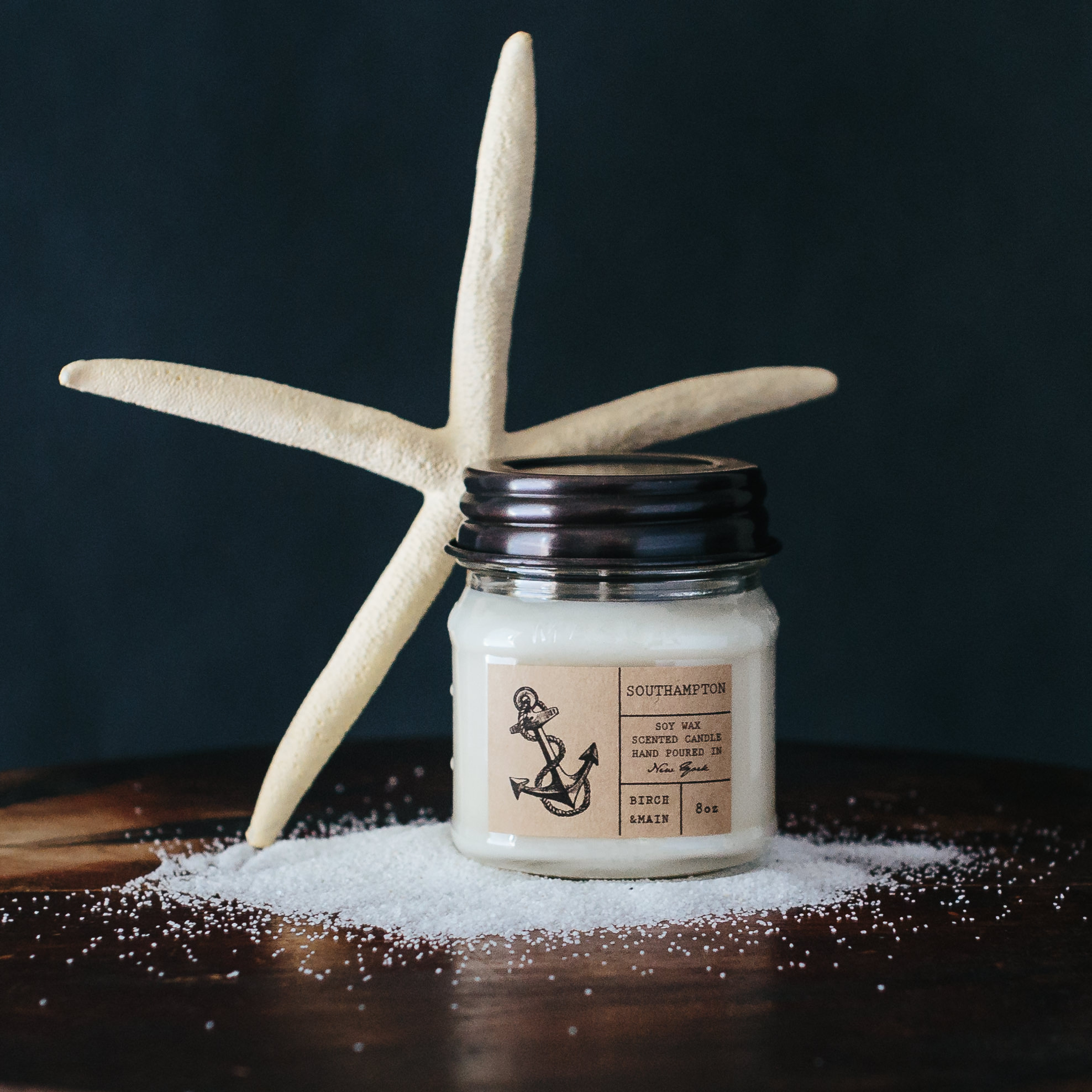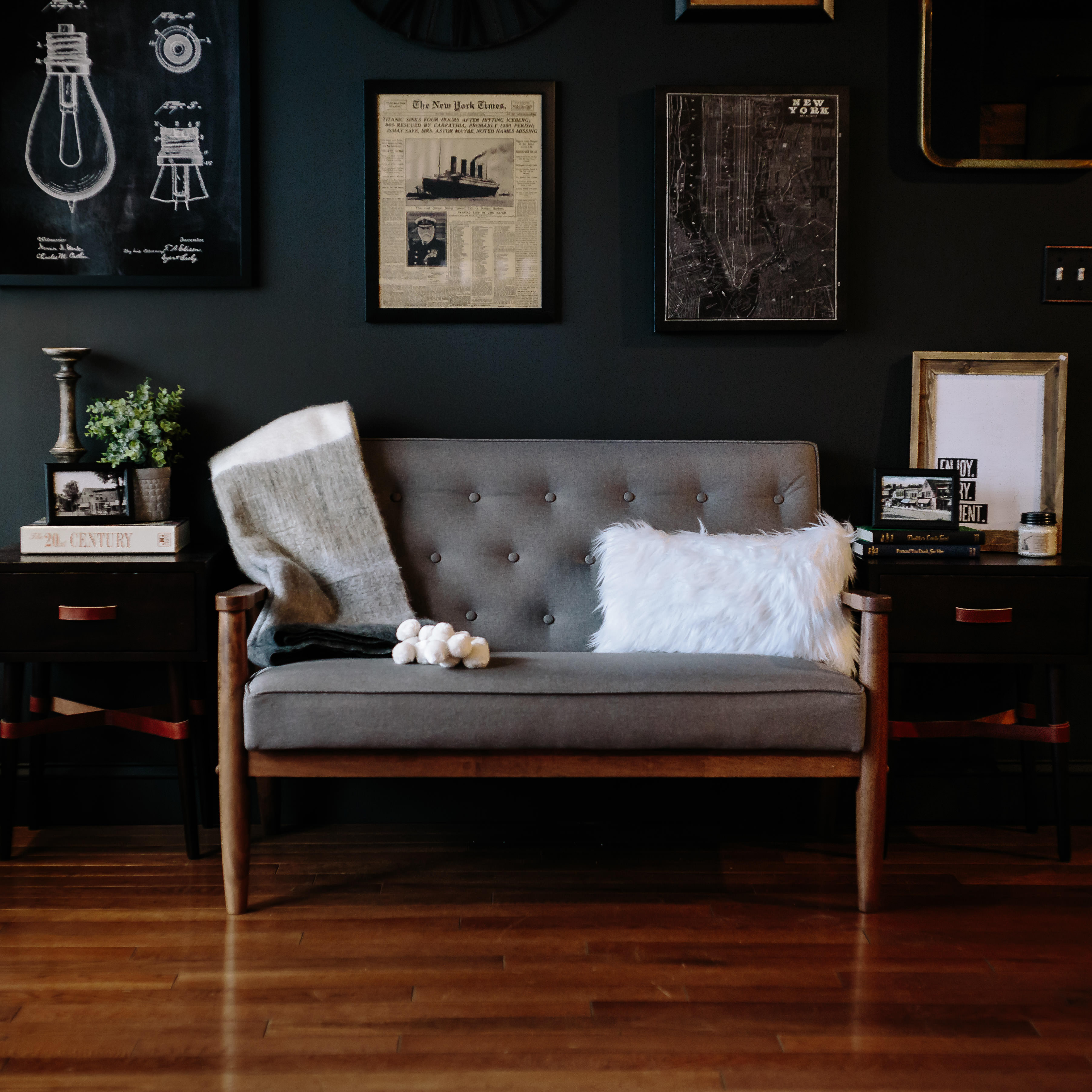
One step in Birch and Main and you’re eyes are everywhere. You immediately get this burst of inspiration and you don’t know where to begin. The colors and textures so meticulously planned and laid out, it’s a vision that’s enticing. Two steps in and the smell of oak calms you.
There are two men standing behind a rustic custom built counter, an apothecary theme you will see throughout the store to keep a cohesive look. The wood detailing blends with the oaky scent. They greet me like we are old friends and soon I feel like we are. They’re inviting nature matches their shop “come, relax, get cozy.”
Michael is the owner of this beautiful shop in Port Jefferson. He speaks with passion for every little detail and it’s clear why he is successful. His background in design gives him an acute eye that has guided him to create such a polished brand in the first place. Charles is his right hand man. He helps bring his vision to life through photography, web design, and SEO (Search Engine Optimization). A partnership they consistently talk about that defines the success of this company.
It’s 2012, Michael burns candles daily in his newly decorated all white, airy and bright home. So much so, that he started to notice black soot on the ceilings as a result of the chemicals constantly burning. “If this is what’s on our ceilings, what could it be doing to people?”, he asked himself before diving head first into new hobby. He created his own soy based candle that turned into an Etsy store, then into a little shop, and then a big one, and now a brand that is carried in over 110 stores across the country and growing. Whats next? Keep reading.
So, I wanted to sit down with Birch and Main to learn the how.How he did it, how he overcame the challenges, how he succeeded, and how the failures have taught him lessons. In doing so, my goal is to showcase and applaud the work that goes into being a small business owner and also to inspire people to shop local. And for anyone who needs the extra motivation to get out there and start your own venture, here it is!
So let’s jump right in.
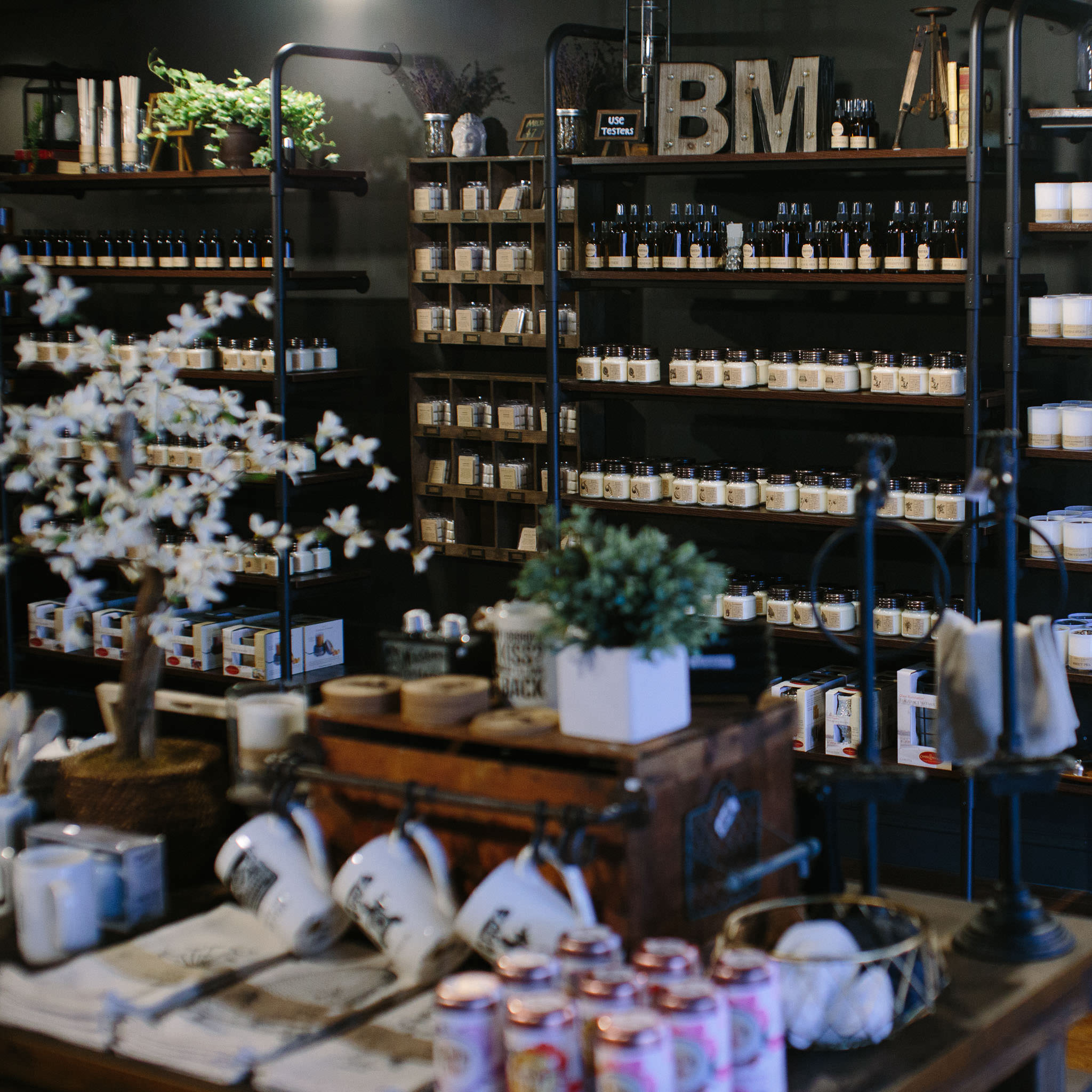
FROM A HOBBY TO A BRAND
How did you start?
Michael: So I started making candles in 2012. It took a few years before it started to blossom into a business. I was really doing it as a hobby. I had an Etsy account, but 2016 we mark as the beginning of our brand and company when I opened my first store front.
How did you learn to make a candle?
Michael: I’m all self taught. I’m a candle freak. We started getting soot marks on our ceiling so I started researching how to make natural candles. It was a lot of trial and error all done in my little kitchen. A lot of money was spent. Youtube, books, so many Facebook groups. The basic concept of making a candle is not difficult. Getting a candle to actually work is the trouble. There’s a lot of science to it.
So when you were creating and designing this candle, were you just thinking of it as a business?
Michael: No, I wanted it for myself. I was in retail in a very good paying job. In about a year or so, it naturally grew itself. Word of mouth from friends and family helped me grow.
When did you quit your retail job?
Michael: Right before I opened my store. I was a store manager at Theory. I worked every day and went home and made candles, lotions, soaps, etc. It would be [the] laughing joke, “what are you doing tonight? Making candles.” Yeah, actually. [laughs] I kept my job until right before construction of the store. When I started out, it wasn’t like I had all of this money saved up. I took out a personal loan. But I didn’t take out something that was too crazy. We gave a lux design with a small budget.
Even when you were making them for your own self, were you branding them the way you do now?
Michael: Yes, it did help that I have a design background and I worked retail so I know the whole ins and outs of the retail industry. There was a lot of time and money that went into design once we decided we were going to start selling outside of our scope of friends and family. We had a design before we actually started an Etsy or website. We didn’t want to just bring it out and it look like a handmade candle. It has to look like something that could be on a store shelf. You can’t just do wonky-willy whatever you want to do, this design, that design. You have to have a brand.
What programs do you use for creating labels?
Michael: Our photographer, Charles, is amazing. I didn’t know anything about computer programs so I can’t take any credit there. It was a partnership between us both because he has the computer knowledge and I have the design.
Charles: I used Indesign for the labels. For photography, it’s Lightroom and Photoshop.
Did you have a moment when you were doing it as a hobby where you were like “I can really make money from this” or this is bigger than I thought it was going to be?
Michael: You know what’s weird, I can’t remember the moment.
Charles: He started mentioning to people that he makes candles and people were asking how much? They wanted to actively buy it from him. He was like I’m going to start charging $10-12.
Michael: So crazy inexpensive.
Charles: He sold like 30-40 candles. After doing that for like 6 months I think he just woke up one day and was like “I’m going to open a store,” went to East Wind, and signed a lease.
Michael [laughs]: I never thought my business would be retail front. I thought when we were starting a business we would just do online, Etsy and our website. I was pumpkin picking with my husband on the east end and we drove passed this place. When I saw the shops at East Wind, I knew it was the perfect space for me. It resonated with me and that’s what really motivated me to open the store. If I didn’t see that shop, I don’t think I would have ever opened a store because I would have been too scared. But I saw that one, I was just like “oh my God, I’m doing this!” and then then I was like “‘oh my God, what did I just do?”
People who are just starting off, I feel like one of the biggest hurdles to get over is finding their worth and their value in what they’re creating and asking for money for it. Was that hard for you?
YES, YES, YES, YES, YES, Great question.
A quick story:
When we first opened Wading River, I think I may have had priced them for 2 for $20. Something so ridiculous that if I was selling them for that I don’t know how I would have paid my rent. I knew I was using very high quality fragrance oil, expensive wax, everything we were using was premium. So it showed as premium, but I was too scared to charge what my product was worth.
A marketing director for the whole East Wind center was in our store when we first opened. She pulled me aside and was like “your prices are way too low.” At that exact moment, it was like a switch. She was like “you’re never going to make it selling this low. Your stuff is really good. You need to charge more.” That exact day we sat down and started talking pricing strategy.
But it’s still a struggle everyday to charge enough to make a profit, but we don’t want to overprice ourselves, especially in a market like Long Island. We have the luxury of having the city an hour away from us. So when we try to price within the market, sometimes its a little pricey for Long Island. For instance, if you go to our competitors some of them use the exact same gold jar. If you buy ours in store it’s 1 for $18 or 2 for $30. Our competitors are selling them for $28-$32 each. So it’s a struggle.
Also with pricing, the lower your price the less people find value in it. If you price it high people are like, “WOW, this must be the best.”
Michael: So funny you say that. Charles says that all the time. When you price it low, people think it’s cheap and they don’t want it.
Charles: There’s a video where Payless rented a space in a high end mall and designed it to look luxury and then displayed their products like a luxury store would. They priced their shoes for like $600. They called themselves “Palessi” and then they invited social media influencers to go shop. It was their largest new store opening in the companies history and it was literally fake. The bloggers were going crazy.
Michael:Perception is reality! If you didn’t know it was a social experiment, the store looked like Gucci.

SOCIAL MEDIA
I love your Instagram. It’s so cool and so well branded. Do you guys have a studio?
Michael: We use our studio in the back, our homes, the sale floors. We do it all over the place. It depends on where you get the best light.
Natural or studio light?
Charles: Natural light with foams boards to bounce the light. The black is just a big roll of black paper. We use the counter sometimes because of the back wall.
It’s so clean and well done. So often you see local businesses that don’t know how to manage their social media accounts and I feel like it negatively effects their brand.
Michael:I totally agree with you on that. The #1 priority when you start to do social media is to realize the impact that it does have on your business.
When we started our instagram we knew we wanted it to be more of a mood board. I really wanted it to be aesthetically pleasing. We don’t do many store shots or random photos on Instagram because we try to keep the images very clean. But that’s why we will use Facebook as well.
Facebook is super important to us because that’s where we’ll post a lot of our informational things that we don’t want to post on Instagram because it will mess up our pretty feed.
Facebook is for information or sale. Instagram is just a mood board and portfolio.
Do you think Instagram and Facebook help you generate more sales? Do you see the conversion?
Michael: Yes, I would say 70% of traffic to our website comes directly from our social media platforms. I would say 40% of that comes directly from Instagram. You definitely see an increase in sales, but you have to keep it very cohesive and clean to make people want to shop it.
How do you get your audience to engage with you?
Michael:It’s not easy and it takes a lot of work. There’s no quick scheme where you’re going to get 10,000 followers overnight. We can sit there 8 hours straight just liking posts and commenting on things. The #1 thing is to just be active. If you want people to be active with you, you have to be active back.
That’s why companies have people dedicated to just social media. That’s how important it is to business now-a-days, especially for small business where it is a struggle competing with the bigger box stores or Amazon. That’s how you compete by engaging with your audience.
Charles: If you sit there for 3 hours and like and engage, you’ll wake up the next morning with 120 followers, but you have to consistently do it or you’ll see your numbers drop.
Michael: You also want to be clever with your captions and wording.
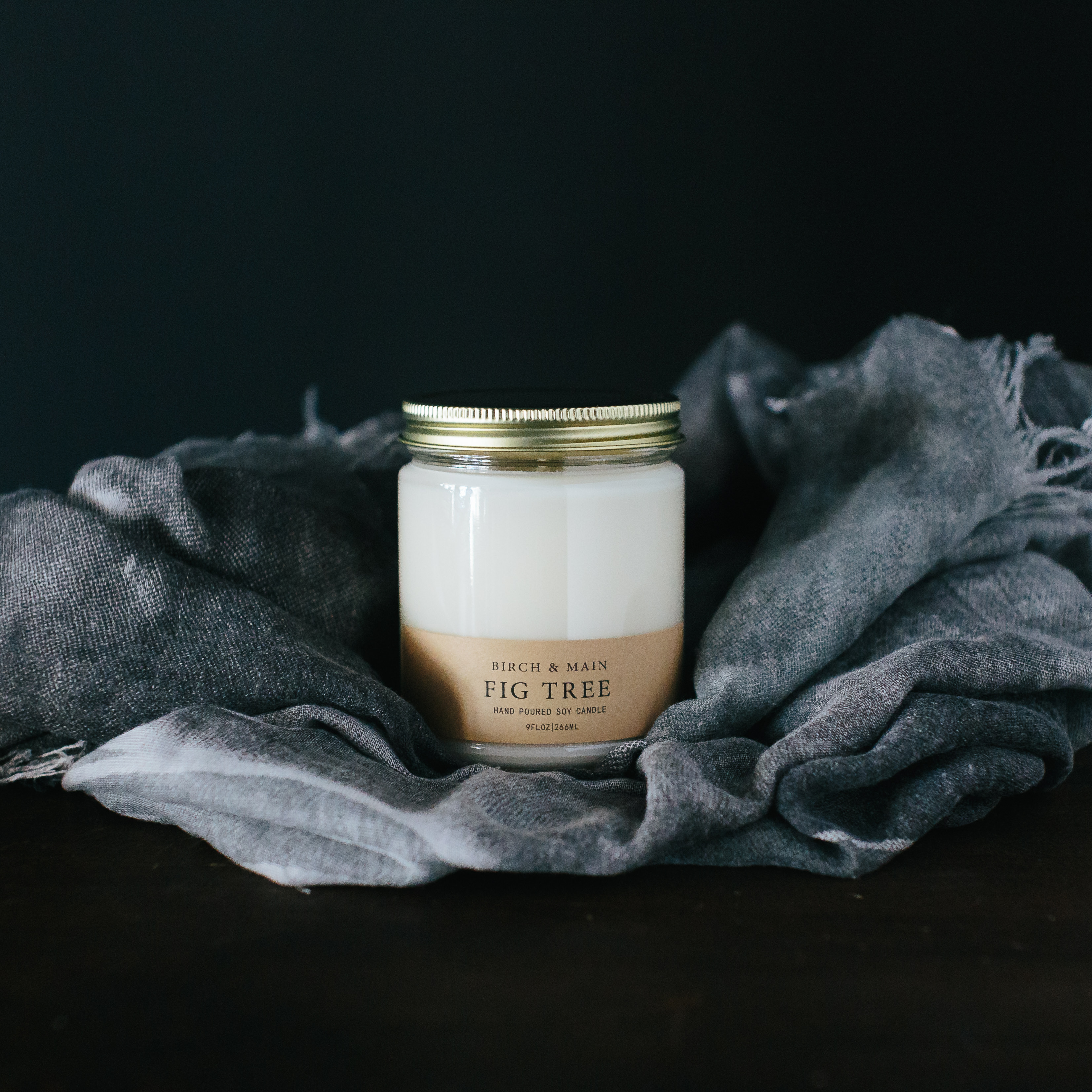
MARKETING & ADVERTISING
Michael: We put out ads in local newspapers. We looked for the cheapest ad spot we could get that cost maybe $100-$200, but it got our name out there.
We did attend a fair here and there, but it didn’t really work out for us so we knew we weren’t going to invest any more money in it.
That’s important to know as a small business owner; cut your losses where you can cut your losses. If the markets aren’t working for you, don’t keep trying to make it work. If it’s not good for your business model, then just forget it.
Charles: It’s 90% trial and error.
Michael: Our POS (Point of Sales) system automatically collects e-mail address so we do have a mailing list. Once a month we send out an e-mail blast letting people knowing what’s going on in the store, if we have any new scents, or collections. That’s a great way to reach people.
*The point of sale (POS) system is the place where your customer executes the payment for goods or services bought from your company. To learn more, you can click here. *
Have you guys ever reached out to NY Influencers and or gifted your candles?
We want to start working with blogger and influencers. We’re going to be sending out free products. If they love it, hopefully they’ll do a review and share it with their following and hopefully that gives us a return.
It helps when our retailers do that as well. When a store that carries our products share it on their Instagram, it brings us more business. I’ve gotten endless customers directly from our website that found us through one of our retail stores, loved it, and now they’re buying through us directly. It definitely does help.
Moving forward working with influencers, we have to find the ones that are on brand, legitimate, and will get us a return on investment. If they have 800k followers, their rate is so high it doesn’t make sense for us. So what’s better 10 people who have a strong engagement and are a bit smaller or 1 person with a huge following?
When we first started out, I never thought of wholesale or as a brand who would want to be in Anthropology. I thought of myself as a local, that stayed local, and supported local. My mindset has grown out of that, but I still love working with our local community. I want to give back to Long Island like Long Island has given to me. This is my home. I would prefer to work with a smaller person because it would be little bit more authentic. It makes sense to work with Long Island influencers because there’s really where our audience is.
I’m looking to collaborate for more lifestyle shots. I want to see our candles in your bathroom, a grapefruit candle in your kitchen, more for imagery.
Have you found that working with other Long Island businesses is effective in reaching a L.I. audience?
Michael: We have worked with amazing L.I. brands like Local L.I. Bred, which is a subscription box that only has local L.I. artists. That’s been amazing. Our amazing stockist that we have spread throughout the island has really given us exposure and helped us with the L.I. crowd. But its also hard as a small business trying to be friends or partner with another business that is selling product that are similar to yours. Every store sells candles.
Did you use a web designer?
Michael: Charles
Charles: It was a collaboration of both of us.
Michael: It’s important to pay someone who knows the behind the scenes of that. I didn’t know what SEO (Search Engine Optimization) was, or hashtagging photos, or hyperlinking. I knew nothing. I thought you just put pictures on a website, you click it and purchase it.
It’s important to budget things out to include things like that. If you want a professional website that’s going to get you sales, invest in that website. My website would never be #1 when you search Birch & Main if it wasn’t for him knowing SEO.
Same thing with your social media, when someone goes to your website they want it to look professional and polished. I personally know if I go on a website and if it doesn’t look legitimate or looks like a small owner, I’m not as comfortable purchasing from there. Maybe I’m scared of fraud or not getting the product. People are more trusting if it looks like a legitimate website.
[to Charles] Did you know SEO or did you learn it from Birch & Main?
Charles:A little bit. Google is free, but there’s a lot of information out there that’s really generalized and it takes time to weave through all of the excess and false information.
Michael: A huge part of being a business owner is your willingness to do the research and educate yourself. It’s going to be time consuming. I’m always working and it’s not necessarily just production. You need to put time into it especially if you’re not working with a huge budget. You can learn anything yourself by just opening up your computer.
* In simple terms, SEO (Search Engine Optimatization is the unpaid strategies used to increase the number of visitors to a website. The goal is to be the #1 search on the first page of Google to optimize traffic To learn more, you can click here. *
WHOLESALE
Do you have a story of the worst challenge that happened to you? Like complete chaos while you were trying to create your business?
Michael: Opening this store. When it rains here, [Port Jefferson] it floods. The day before this store opens, I come in and there’s a massive leak in my store coming out of all the light fixtures, down all the walls, you can still see bubbling over there. I just start crying. I was like I still don’t have a sign, now I have a leak through my ceiling. That was really terrifying.
We opened and had a successful grand opening. But we quickly realized that business here is not what it was going to be like in Wading River. Moving to this bigger space with a bigger town with more traffic, didn’t necessarily mean bigger sales, but we had bigger bills. That’s when I started stressing out and thinking, I just made the worst decision of my life. I just destroyed my business. What did I do to myself? I’m not going to survive here. I had to pick myself up and remind myself, “you devoted a lot of time, sweat, tears.” It is really easy to give up, but that was never an option for me. I was going to make it work no matter what I had to do.
This taught me a lot and I thought I knew everything. Almost out of necessity, we had to come up with other revenue streams, which is why we went into wholesale. Doing wholesale in the quantity that were doing now has opened so many doors for Birch & Main as a brand that were super excited to share coming in 2019. The retail is still a struggle but the opportunities that I got from struggling here is far greater than what I would have ever gotten from our previous store.
I read that you just received 85 retail accounts since July.
Michael: Yes, we have 110 accounts now. So we are all over the U.S. This year, our goal is to start working major retailers like Whole Foods or Anthropology. All of our products are natural, vegan, no color dyes. They’re all soy wax. We’re in the holistic, healthy market so that’s our major plan for 2019 to start branching off into biggerretailers.
I think so often people are like, “someone should create this product, this app, or you know what would be a great idea..” To them, it’s unfeasible that a normal human being that has an idea can take it and create something from it and grow it into a business. I think sometimes people are little bit embarrassed by their ideas or it’s too audacious. They want to keep themselves small because they don’t want people to be like, well who do you think you are that you think you can be in Anthropology?
Michael: I love that you said that. That is my #1 thing. You are bigger than you are. Whenever you speak to anybody, you must present yourself and your business bigger than it is. When we first started out with wholesale, we had 3 accounts. We just marketed it as “were a brand carried in multiple stores across the island.” You have to give that presentation if you want to be someone. That was the biggest piece of advice we received from other brands that started small. When we were approaching retailers we never actedlike, “I’m making candles out of my kitchen.” That’s how people take you seriously and that’s how you grow. You never want to think too small. If you want to grow, you have to think big. You truly never know where you can go from here.
Charles: Whatever your version of success is at the top of the stairs, people think you’re making these huge jumps and leaps. But its really one little baby step over time. It could take 10 years of consistent baby steps to get there.
Where do you find your wholesalers?
Michael: First, we started reaching out to people ourselves, but it’s marketplaces like Faire and trade shows like NY Now. Those are really the core of our wholesale business now.
We did start reaching out to a lot of boutiques across Long Island and the country. But for every 1 yes, we got 100 no’s, so we had to have really thick skin. We were ready to be told no or just be completely ignored. You can’t let that get you down. You have to keep going. So we constantly just kept emailing, following up, sending our products out. That wasn’t proving too successful.
We were invited to join a platform called Faire; a marketplace for makers. It’s like Etsy but for retailers to shop. You have to be a legitimate business. They proof everyone before and that is what boomed our wholesale. It was almost overnight. We were getting a new account every day. Some weeks we were getting 20 new accounts. The demand blew up and then that became a challenge. We had to keep up with all of these orders while trying to have the store stocked. We weren’t expecting the response we got and we weren’t prepared to be shipping out 400 candles a week. We had to adjust. Growing too quick can really hinder you. That could have snapped us right in half. The orders were coming in so rapidly and we were out of supplies.
For wholesale, how do you make this amount of candles?
Michael: It’s crazy. We have an in home studio in Yapank. We have a small studio space here. It’s a 6 day a week job. The only day of the week we take off is Sundays because Sundays we use for office time. It’s a lot of work. It’s constant going, going, going.
How many employees do you have making candles?
Michael: We have 2 part time production assistants and me. So 3 of us.
There’s only 3 of you making this amount of candles? Are you kidding me? I thought you had a factory.
Michael: We are getting there. Our operation is getting so big now, we’re outgrowing it. It’s insane. And we don’t just sell candles.
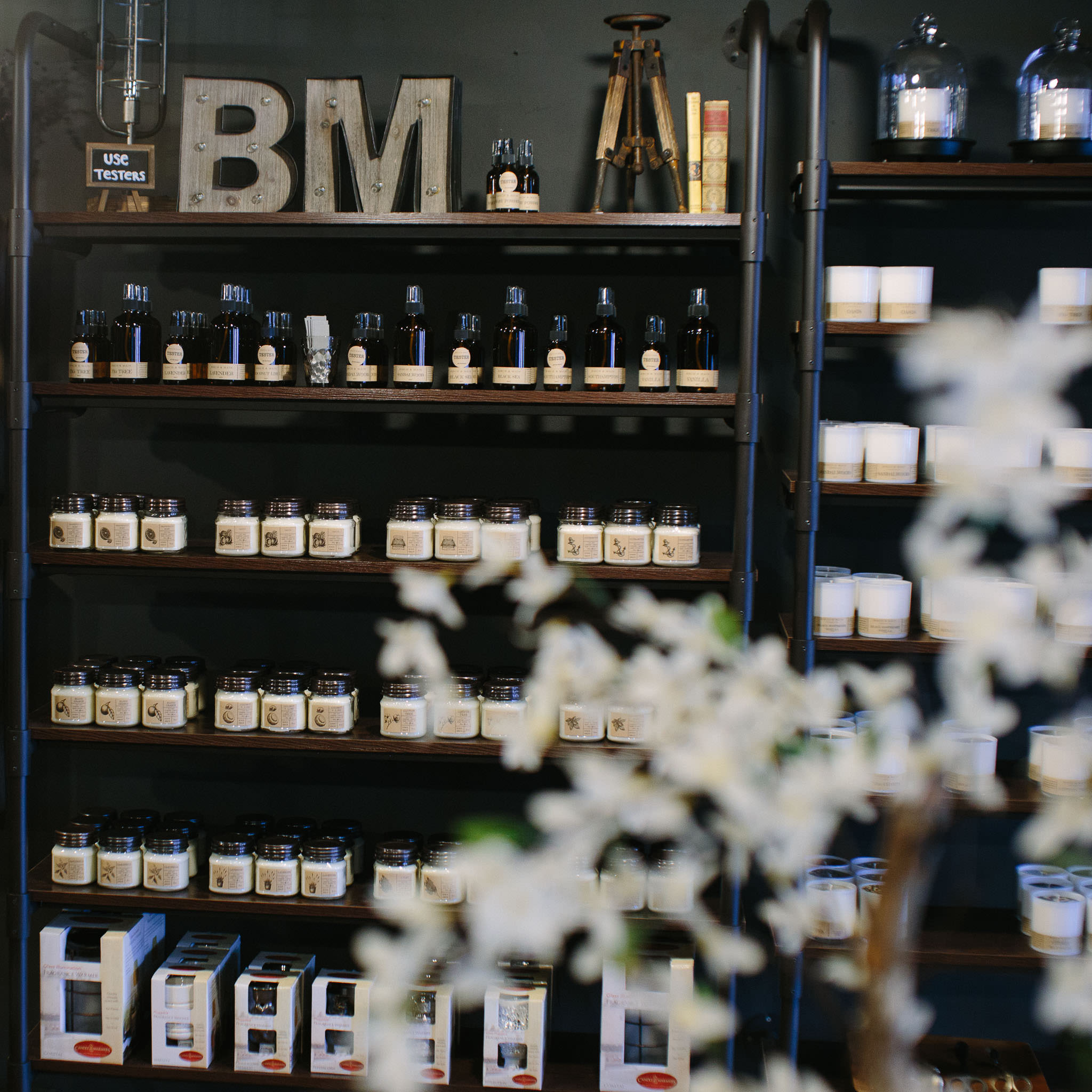
RESOURCES & EDUCATION
Did you have resources that you used to help guide you? Do you have mentors?
Michael: There is the Small Business Association of Long Island. I had a great mentor there that helped me start out the business. Anyone that is looking to start out a business or start something new, there is a lot of help and resources out there. The SBA of LI is absolutely free. Anyone can go there. They are high level executives that are either retired or still working in their field. It’s a great resource to have. They can answer any of your questions and will even help you with all the legal and sales tax.
Did you use any books, podcasts?
Michael:Youtube! There’s information out there on everything. Resources like Legal Zoom were extremely helpful. When we first started out we were going to be a Sole Prop., when we decided to become an LLC., that whole paperwork was just too much. For a small fee, Legal Zoom will take care of all that for you.
Setting things up like your legal name is just an online form. As far as tackling the taxes, I was getting a little worried. We got an accountant right away. Speaking to a CPA is vital. That was probably the most confusing thing to me about starting a business.
Charles:In terms of taxes and legal, that’s where a lot of small businesses get in trouble where they have to close. A normal person doesn’t think about taxes and then you give all your paper work in and they’re like okay you owe $25,000. Besides marketing and branding, getting an accountant is the most important thing business owners have to do.
Because it was a hobby that turned into a business and you got the confidence from seeing people reacting positively to your products, you never had that moment of like “oh my god, is this a good idea?”
Michael: When I signed the lease to my first store, I was like “oh my god, what did I just do?” I still get those moments like, what am I doing, how am I going to do this, but opening my first retail store was like, Can I afford this? What if we don’t make money? Ok, I just need to make $50 a day to pay the rent.
Do you have any advice for someone who is starting a business?
Michael: Just do it. Don’t let fear stop you. If you don’t succeed, that’s fine but at least you did it.
Charles: Growth doesn’t come from being comfortable. You have to constantly push yourself and try things. There’s a lot of learning from failure. You want to lock it in the closet and put chains over it, but every time you fail you learn what not to do.
Michael: If failure didn’t happen, I would have never learn how to fix it in the future. Every failure has a story.
I left this conversation feeling like I just took an entire class on small business. What I learned from Michael and Charles is that you don’t need to know the big picture, the grand finale, what’s waiting for you at the finish line. Because there is no finish line. You will never know what’s next. But you do need to let yourself grow and that means starting now and you have to be committed to learning all that you can along the way.
Thank you guys for sitting down with me.
Thank you for trusting me with your story.
Until next time.
XOXO,
CK
